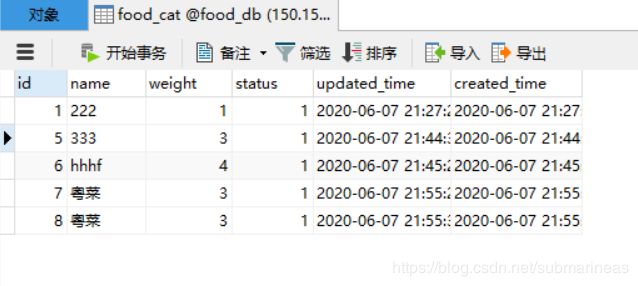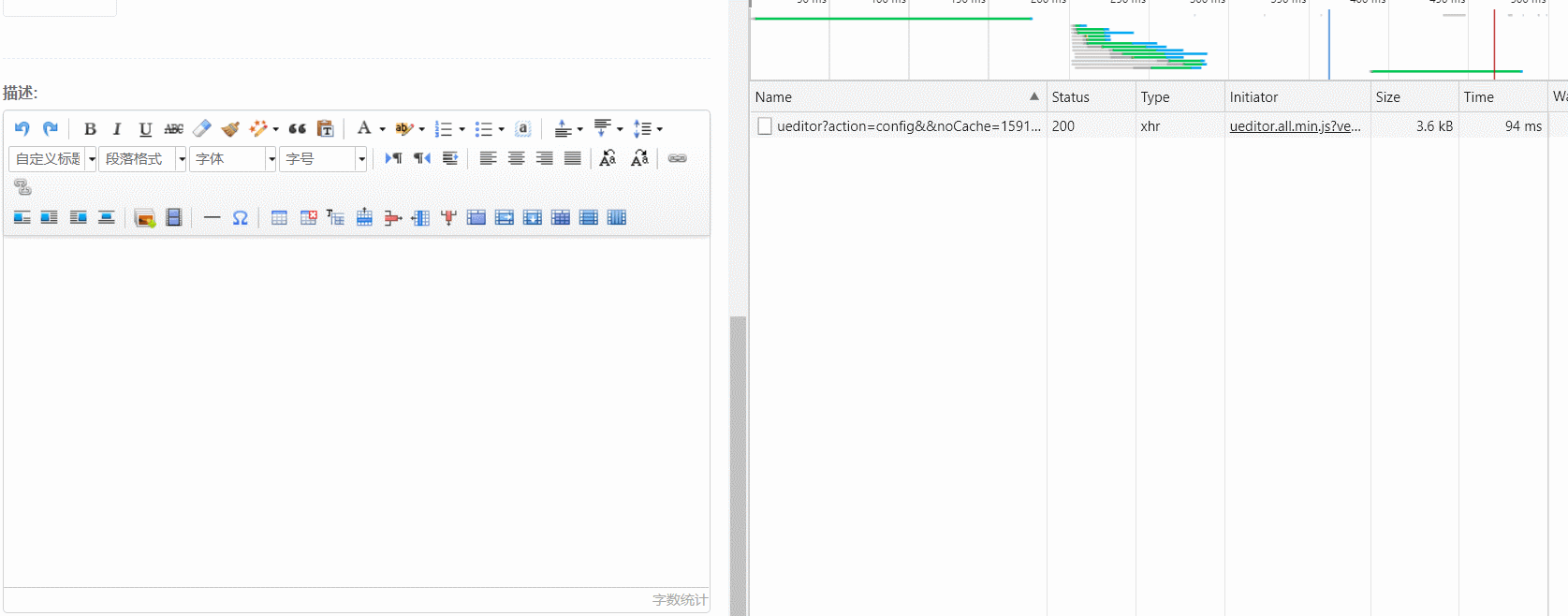Python Flask 微信小程序点餐系统(五):管理员后台菜品模块
菜品模块架构
- 菜品相关数据表设计
- 菜品分类列表
- 添加 / 编辑 / 删除 / 恢复菜品分类
- 菜品列表
- 添加 / 编辑 / 删除 / 恢复菜品
- 菜品库存变更历史
表结构设计
CREATE TABLE `food_cat` (
`id` int(11) unsigned NOT NULL AUTO_INCREMENT,
`name` varchar(50) NOT NULL DEFAULT '' COMMENT '类别名称',
`weight` tinyint(4) NOT NULL DEFAULT '1' COMMENT '权重',
`status` tinyint(1) NOT NULL DEFAULT '1' COMMENT '状态 1:有效 0:无效',
`updated_time` timestamp NOT NULL DEFAULT CURRENT_TIMESTAMP COMMENT '最后一次更新时间',
`created_time` timestamp NOT NULL DEFAULT CURRENT_TIMESTAMP COMMENT '插入时间',
PRIMARY KEY (`id`),
UNIQUE KEY `idx_name` (`id`)
) ENGINE=InnoDB DEFAULT CHARSET=utf8mb4 COMMENT='食品分类';
以及同时定义的另外food、foodsalechangelog和foodstockchangelog三张表
代码书写
首先对于food.py文件中,我们可以看到相关文件如下:
route_food = Blueprint( 'food_page',__name__ )
@route_food.route( "/index" )
def index():
return render_template( "food/index.html" )
@route_food.route( "/info" )
def info():
return render_template( "food/info.html" )
@route_food.route( "/set" )
def set():
return render_template( "food/set.html" )
@route_food.route( "/cat" )
def cat():
return render_template( "food/cat.html" )
@route_food.route( "/cat-set" )
def catSet():
return render_template( "food/cat_set.html" )
我们先对分类的编辑和创建接口进行书写:
@route_food.route( "/cat" ) # 分类列表的展示功能
def cat():
resp_data = {}
req = request.values
query = FoodCat.query
if 'status' in req and int( req['status'] ) > -1:
query = query.filter( FoodCat.status == int( req['status'] ) )
list = query.order_by( FoodCat.weight.desc(),FoodCat.id.desc() ).all()
resp_data['list'] = list
resp_data['search_con'] = req
resp_data['status_mapping'] = app.config['STATUS_MAPPING']
resp_data['current'] = 'cat'
return ops_render( "food/cat.html",resp_data )
@route_food.route( "/cat-set" ) # 美餐管理分类中的编辑和创建接口
def catSet():
if request.method == "GET": # get请求
resp_data = {}
req = request.args
id = int(req.get("id",0))
info = None
if id:
info = FoodCat.query.filter_by(id=id).first()
resp_data["info"] = info
resp_data["current"] = "cat"
return ops_render( "food/cat_set.html" )
resp = {"code":200,"msg":"操作成功~~","data":{}} # 开始post请求
req = request.values
id = req["id"] if "id" in req else 0
name = req["name"] if "name" in req else ""
weight = int(req["weight"]) if ("weight" in req and int(req["weight"]) > 0) else 1
if name is None or len(name) < 1:
resp["code"] = -1
resp["msg"] = "请输入符合规范的分类名称~~"
food_cat_info = FoodCat.query.filter_by(id = id).first()
if food_cat_info:
model_food_cat = food_cat_info
else:
model_food_cat = FoodCat()
model_food_cat.created_time = getCurrentDate()
model_food_cat.name = name
model_food_cat.weight = weight
model_food_cat.updated_time = getCurrentDate()
db.session.add(model_food_cat)
db.session.commit()
return jsonify( resp )
后端逻辑和之前类似,我也是好久没敲了,但感觉换汤不换药,都是差不多逻辑,这篇的难点基本都在前端,但我重点介绍后面的吧,这里的前端逻辑就是需要根据后端更改的字段,将cat_set页面更改为相应形式,关于weight权重可以这样设置:{% if info and info.weight > 0 %}{{ info.weight }}{% else %}1{% endif%},写成一行,确实美观。js和之前一样也没有多大改动。另外和Linux不同的是载入配置文件的命令,两个区别如下:
#windows:
set ops-config=local && python manager.py runserver
#linux:
export ops-config=local && python manager.py runserver
然后我们还需要写页面展示和删除功能,才能在页面上显示出具体的更新,其实现在已经可以测试了,只不过只是数据库变化,页面上没有显示:

然后我们可以从数据库看到记录,当时网速有点差,所以点了两次,可以看到数据库中出现同时间两次。

再添加上分类展示,以及统一处理的两个接口,那么分类列表里的增删改查就做完了:
@route_food.route( "/cat" )
def cat():
resp_data = {}
req = request.values
query = FoodCat.query
if 'status' in req and int( req['status'] ) > -1:
query = query.filter( FoodCat.status == int( req['status'] ) )
list = query.order_by( FoodCat.weight.desc(),FoodCat.id.desc() ).all()
resp_data['list'] = list
resp_data['search_con'] = req
resp_data['status_mapping'] = app.config['STATUS_MAPPING']
resp_data['current'] = 'cat'
return ops_render( "food/cat.html",resp_data )
@route_food.route("/cat-ops",methods = [ "POST" ])
def catOps():
resp = {'code': 200, 'msg': '操作成功~~', 'data': {}}
req = request.values
id = req['id'] if 'id' in req else 0
act = req['act'] if 'act' in req else ''
if not id :
resp['code'] = -1
resp['msg'] = "请选择要操作的账号~~"
return jsonify(resp)
if act not in [ 'remove','recover' ] :
resp['code'] = -1
resp['msg'] = "操作有误,请重试~~"
return jsonify(resp)
food_cat_info = FoodCat.query.filter_by( id= id ).first()
if not food_cat_info:
resp['code'] = -1
resp['msg'] = "指定分类不存在~~"
return jsonify(resp)
if act == "remove":
food_cat_info.status = 0
elif act == "recover":
food_cat_info.status = 1
food_cat_info.update_time = getCurrentDate()
db.session.add( food_cat_info )
db.session.commit()
return jsonify(resp)
前端中修改cat.html和相应的cat.js就能测试了,比较难改的地方在可选框的状态,这条语句有点长为
<select name="status" class="form-control inline">
<option value="-1">请选择状态</option>
{% for tmp_key in status_mapping %}
<option value="{{ tmp_key }}" {% if tmp_key == search_con['status'] %} selected {% endif %}>{{ status_mapping[ tmp_key ] }}</option>
{% endfor %}
</select>
这个是判断status_mapping搜索框状态,1表示正常,0表示删除,search_con为可选框的值,这里做了两次判断两次选值还是很能证明jinjia2的写法。
然后我们就能看见最终结果:
ueditor可视化编辑器步骤
ueditor的文本编辑器可以看http://fex.baidu.com/ueditor/,我们只需要按照文档中所写的那样一步步去配置。首先下载好安装包放进项目文件中的plugin文件夹下,然后在前端的food/set.html中导入相关文件:
<script src="{{ buildStaticUrl( '/plugins/ueditor/ueditor.config.js' ) }}"></script>
<script src="{{ buildStaticUrl( '/plugins/ueditor/ueditor.all.min.js' ) }}"></script>
<script src="{{ buildStaticUrl( '/plugins/ueditor/lang/zh-cn/zh-cn.js' ) }}"></script>
<script src="{{ buildStaticUrl( '/js/food/set.js' ) }}"></script>
最后一个为我们自定义的js文件,按照ueditor文档中所写的那样,关键代码为var ue = UE.getEditor(‘container’);
js文件为:
var food_set_ops = {
init:function () {
this.eventBind();
this.initEditor();
},
eventBind:function () {
},
initEditor:function () {
var that = this;
that.ue = UE.getEditor("editor");
}
};
$(document).ready(function () {
food_set_ops.init();
});
上面虽然有可视化编辑器了,但我们需要完善后端逻辑,首先写图片上传函数:
# -*- coding: utf-8 -*-
from werkzeug.utils import secure_filename
from application import app,db
from common.libs.Helper import getCurrentDate
import datetime
import os,stat,uuid
from common.models.Image import Image
class UploadService():
@staticmethod
def uploadByFile( file ):
config_upload = app.config['UPLOAD'] # """{'ext':[ 'jpg','gif','bmp','jpeg','png' ],'prefix_path':'/web/static/upload/','prefix_url':'/static/upload/'}"""
resp = { 'code':200,'msg':'操作成功~~','data':{} }
filename = secure_filename( file.filename ) # 得到一个安全验证的文件
ext = filename.rsplit(".",1)[1] # 0是文件名,1是扩展后缀
if ext not in config_upload['ext']: # 检查文件后缀
resp['code'] = -1
resp['msg'] = "不允许的扩展类型文件"
return resp
root_path = app.root_path + config_upload['prefix_path'] # 创建服务器文件夹名字
file_dir = datetime.datetime.now().strftime("%Y%m%d")
save_dir = root_path + file_dir
if not os.path.exists( save_dir ):
os.mkdir( save_dir )
os.chmod( save_dir,stat.S_IRWXU | stat.S_IRGRP | stat.S_IRWXO )
file_name = str( uuid.uuid4() ).replace("-","") + "." + ext # 组成路径与文件
file.save( "{0}/{1}".format( save_dir,file_name ) )
model_image = Image() # 将图片地址保存到数据库中
model_image.file_key = file_dir + "/" + file_name
model_image.created_time = getCurrentDate()
db.session.add( model_image)
db.session.commit()
resp['data'] = {
'file_key': model_image.file_key
}
return resp
然后我们需要写和前端对应的接口,再创建一个upload包,并申请一个蓝图,名字为route_upload,前缀为url_prefix = “/upload”,接口路径为"/ueditor",那么代码为:
# -*- coding: utf-8 -*-
from flask import Blueprint,request,jsonify
from application import app
import re,json
from common.libs.UploadService import UploadService
from common.libs.UrlManager import UrlManager
from common.models.Image import Image
route_upload = Blueprint('upload_page', __name__)
@route_upload.route("/ueditor",methods = [ "GET","POST" ])
def ueditor():
req = request.values
action = req['action'] if 'action' in req else ''
if action == "config":
root_path = app.root_path
config_path = "{0}/web/static/plugins/ueditor/upload_config.json".format( root_path )
with open( config_path,encoding="utf-8" ) as fp:
try:
config_data = json.loads( re.sub( r'\/\*.*\*/' ,'',fp.read() ) )
except:
config_data = {}
return jsonify( config_data )
if action == "uploadimage":
return uploadImage()
if action == "listimage":
return listImage()
return "upload"
def uploadImage(): # 上传图片逻辑
resp = { 'state':'SUCCESS','url':'','title':'','original':'' } # 返回json格式
file_target = request.files
upfile = file_target['upfile'] if 'upfile' in file_target else None
if upfile is None:
resp['state'] = "上传失败"
return jsonify(resp)
ret = UploadService.uploadByFile( upfile )
if ret['code'] != 200:
resp['state'] = "上传失败:" + ret['msg']
return jsonify(resp)
resp['url'] = UrlManager.buildImageUrl( ret['data']['file_key'] )
return jsonify( resp )
def listImage(): # 图片列表展示
resp = { 'state':'SUCCESS','list':[],'start':0 ,'total':0 }
req = request.values
start = int( req['start']) if 'start' in req else 0
page_size = int( req['size']) if 'size' in req else 20
query = Image.query
if start > 0:
query = query.filter( Image.id < start )
list = query.order_by( Image.id.desc() ).limit( page_size ).all()
images = []
if list:
for item in list:
images.append( { 'url': UrlManager.buildImageUrl( item.file_key ) } )
start = item.id
resp['list'] = images
resp['start'] = start
resp['total'] = len( images )
return jsonify( resp )



